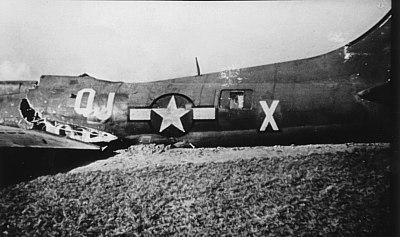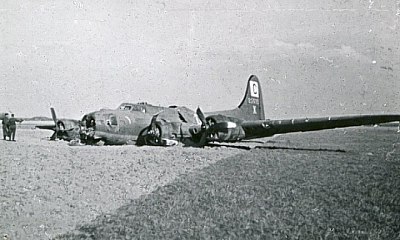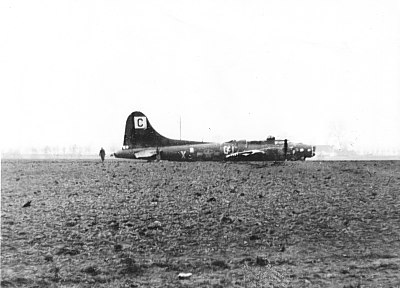 zoom_in
zoom_in
Source:
www.flensted.eu.com
Production-block:
B-17F-75-DL: 42-3504 to 42-3563
B-17G-5-DL: 42-3504 to 42-3563
Manufacturer:
Douglas
- Bomb Group:
- 385th Bomb Group
- 96th Bomb Group
- Bomb Squadron:
- 337th Bomb Squadron
- 339th Bomb Squadron
- RCL: QJ-L, MZ-L
MACR: 4266
History of
B-17 42-3535
Delivered Denver 24/7/43; Dyersburg 7/8/43; Assigned 385BG Great Ashfield 9/9/43; transferred 337BS/96BG [QJ-L] then 339BS [MZ-L] Snetterton 9/9/43; Missing in Action Sorau 11/4/44 with Ken Bethe, Co-pilot: Raoul Demars, Navigator: Hyman Juskowitz, Bombardier: Bob Smith, Flight engineer/top turret gunner: Constantine Segalla, Radio Operator: Bob Esler, Ball turret gunner: Stan Mrozeck, Waist gunner: John Hamlin, Waist gunner: Russell Lauer,Tail gunner: Everett Morgan (10 evaded capture); enemy aircraft hit bomb doors and jammed half-open, #2 on fire; crew bailed and picked up by Danish ship and taken to Scotland; aircraft crash landed St Hedingh, Laaland, Den. Salvaged. Missing Air Crew Report 4266.
Last updated: 13. November 2019
B-17 42-3535 Details
11 April 1944. The B-17 with the s/n 42-3535 of the 8th US Air Force had thrown off straight their charge 500 lb highly explosive and 100 lb incendiary bombs over the factory for synthetic fuel in Politz, Poland, as German fighters attacked and tried out urge the bombers from the formation and to shoot.
Some strategists in the allied Bomber Command had the glorious idea that if three federations (643 bombers) of closely flying Boeing B-17 and Consolidated B-24 on two different routes to a target area deeply to Europe fly, this the enemy would confuse. A federation should fly past into the north Germany and knock two federations into a cross-country course, which should lead it to its targets far behind “Big B” (Berlin). In the theory the defenders should be left thereby in the unclear one over the goal. But this was evenly only theory. The crews knew it better. When at 5.00 o’clock with the Briefing on the homeland basis Snetterton Heath in the English Suffolk the curtains were pulled of the maps, the Murren was not over audible. The principal purposes Poznan, Kreising and some different were approximately 260 km east of Berlin. The crews it was clear that this was already nearly a suicide action. And for the men of the 339th Bomb Squadron, 96th Bomb Group of the 3rd Air Division it should become a long terrible day.
Fortunately for the 339th the route did not lead to the target across the north and Baltic Sea where Flak to fear was. But the opposing interceptors stationed in France and Belgium was initial rather near and also over Denmark and Germany the air defense would be strong. The employment would take twelve hours and should for many it become longer. There were some reasons for this “Madness”. The weather forecast forecast clouds on far parts of the distance, whereby the target area should be clear. Besides one thought that the Germans would regard the approach of the 3rd division as deflection maneuvers as the “large” attack, because the 1st and 2nd division took a direct course, in order to bombard the aircraft plants in Oschersleben and Berne castle, and/or Sorgau and Cottbus. Logical way would direct the Air Force their forces toward the more obvious danger.
But exactly the opposite happened. After reports received later the employment was retarded against the southern federations by the German fighter direction posts. This possibly due to the fact that a similar employment had been flown two days before. Went to everything else likewise inclined. The weather forecasts were wrong and the target area were under clouds. The machines had flying more slowly than normally over for the long distance the precious fuel to save and at a value of approximately 6000 m were the machines an easy target for in this area stationed 202 anti-aircraft guns. Even some ground-to-air rockets were fired. As escort protection two groups of P-47 and a group of P-38 should be available. Of it however only one Thunderbold group (the 353rd) should cover the approach and these turned around 30 to 40 miles after the overflight of the coast. The other groups should cover only the return flight. By the bombers also still the meeting place was missed, so that the two fighter groups met the 339th still later. To all abundance the bombers of the 339th also still eastern of the goal fell, whereby the damage of the target was reduced.
One of the Flying Fortresses penetrating into the “Fortress Europe” on this fateful day was the B-17 #42-3535. With only three common employments their crew was relatively new. When the #42-3535 and the other American bombers approached its goals, 150 km were formed north Berlin convenient Mueritzsee two groups of destroyers over that. 15 BF 110, 20 ME 410 and 15 Ju 88 attacked the federation and shot three B-17. The pathfinders of the bombers could not constitute the primary goal Poznan with radar. Ironically here a cloudy appearance of ten tenths prevailed and besides was smoke generators in enterprise of the leaders of the federation, Colonel Castel, turned the bombers in direction of their secondary targets Stettin, Politz and Rostock. The squadron, to which the #42-3535 belonged, took first course on Stettin, since Stettin was intended as secondary target with bad weather conditions. When the clouds broke, the federation pivoted however on Politz. To the release the pilot, 2nd LT went. Ken Bethe, still with reduced speed on homeland course. But before the bomb flaps were closed went an impact through the machine. One directly under the B-17 exploding flakgranate shook the airplane in its essential structure.
The damages were small, but the bomb flaps had blocked themselves in half-open position. More badly still it was however that the engine NR. and the propeller failed 3 in sailing position to bring did not leave themselves. This meant additional resistance. Bethe and copilot Raoul of the acre wanted the #42-3535 on treetop height down-bring by the discovery risk to decrease, but before the descent could be begun, an attack of the hunters by Rostock, that were occupied with priority with the shot and slower bombers, was made. The attack sets engine NR. 2 except combat and NR. 4 one duke smoke-purely from burning oil behind itself. Also NR. 2 could be only partly brought in sailing position. Enormous air resistance tried to pull the machine from the sky to. To all abundance shattered 20 mm garnet the cockpit glazing whereby a fragment of the acre at the head stepped in such a way that it occurred under the right eye and remained in the oral cavity being. Thus Bethe had to become finished alone with the heavily fastened machine. He knew the fact that its only chance consisted of it Sweden to reach but it was unclearly, whether they would create it at all so far. The last functioning navigational instrument, the magnetic compass, had been destroyed by the explosion in the cockpit. A last attack of German hunters could be gotten over without hits, before these turned off from fuel or lack of ammunition.
Bethe flew the shattered bomber direction north northeast to Denmark. The acre into the radio romm was brought, where John ever Hamlin did not supply the wounds. The on-board contactors Tony Segalla took the left pilot seat (Bethe flew due to the earlier position of the machine in the formation from the right seat) and had with the strength of both legs the left rudder pedal to press, since by air resistance the B-17 pulled to the right. The course hit on suspicion was only difficult because of the damage to keep and besides lost the machine fast at height. The crew tried to answer as it hastily everything from the machine threw which was not needed, with which it left a trace crosswise over the peninsula net curtain Heddinge. Were there also most parachutes damaged went also it over board, because each crew member had itself decided for it “the whole way to down-ride”. When the coast of Denmark was reached, the navigator Hy Juskowitz must probably have suspected the fact that with geography somewhat was not correct because continued to fly and turned it to the north then to the east, where on this beautiful and clear day Sweden was recognizable perhaps already. In addition, with Soholm/Gjorskev still the last engine failed.
Despite its small height Bethe decided to turn south of the Klippinge, because he had seen back a possible emergency landing field to 4 km. The approach took place with approximately 100 knots. Briefly after putting on the right bearing area met a telephone pole, whereby the machine turned to the right, missed scarcely a farm house and ate then into the earth. Bethe had carried whole work out. Left a road and a ditch were, on the right of a high voltage transmission line. The B-17 applied earth, which worked like a strong brake behind the radio room and filled with a ton. It was 14,00 o’clock as the crew without larger injuries (up to the acre, for which one out-carried) the wreck hastily left. They were 60 km of Copenhagen and 125 m a long furrow southern into 300 m a long clover field had plowed. The telefonmast put down during the crash landing proved as extremely helpful, because by the interrupted voice grade channels the message could not be passed on by the forced landing and the wreck of the B-17 by the German occupation troops only against 11.00 o’clock pm was in such a way found. Still larger luck had the crew by the fact that those belonged the break to observed Dane of the resistance movement immediately and worried about the Americans.
After some days of hiding it succeeded to smuggle that outstanding organized Dane the crew on a fishing boat to Sweden. After that the wounds of the acre had healed, flew them with a B-24 (altogether 82 persons!) to Scotland, of where out they were brought to the further questioning to London. Since they had been saved by the Danish underground and these could not be endangered unnecessarily, the crew was drawn from the employment and could return as a transfer crew with a war-tired B-17 to its homeland. This was one of the few crews, which after the firing behind the hostile lines completely the shank could escape.
At this employment were involved over 1200 bombers and fighters. 52 B-17, 12 B-24 and 16 fighters were lost on this day. The 3rd Bomber Division had the heaviest losses with 33 machines. As intended the escort protection left the 3rd Division at the intended point, met no opposing airplanes, lost no machine and obtained thus also no air victories. With the entire employment 13 men was killed, announced to 47 wounded and 654 crew members as missed.
The details of this unusual employment of the #42-3535 can be visited together with an exhibition by individual parts from these B-17 in the Kalamazoo Aviation History Museum in the US, State Michigan.








Write comment